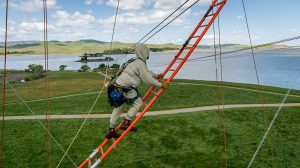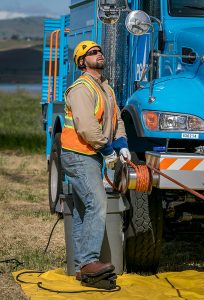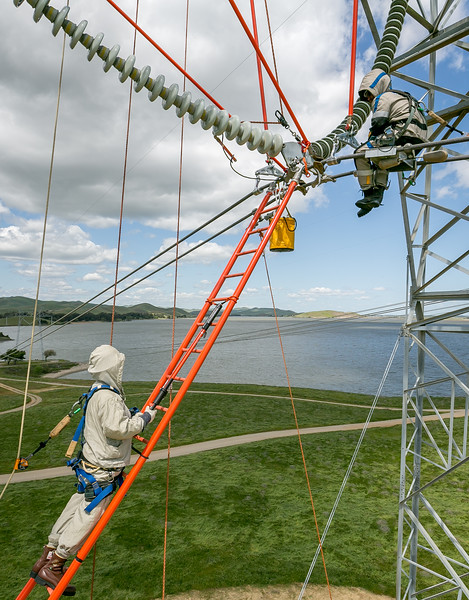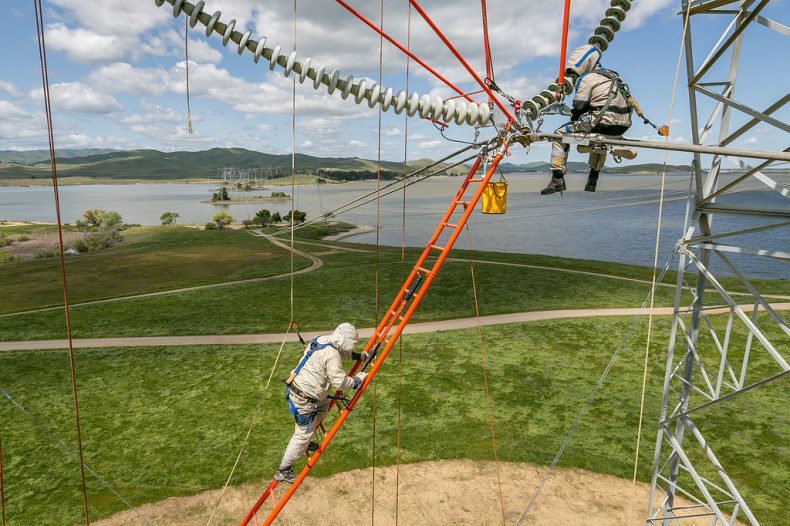In the 1840s, a British scientist named Michael Faraday did an experiment with an ice bucket that would become the basis for the way that barehand utility work is performed, even today.
These ice bucket experiments theorized that electricity will flow around, but not through, something that is encased in a metal object. While both Benjamin Franklin and Giovanni Battista Beccaria were known to have performed similar experiments decades earlier, it was Faraday who is largely credited for this discovery, known as the “Faraday Cage” principle.
Faraday’s theory is required reading for all IBEW 1245 members at PG&E who wish to perform barehand work. Once they complete a course of study in the classroom, they must then demonstrate the work procedure in a supervised field training setting before they are able to perform it on the job.

The Faraday suit is the key component to safe and effective barehand procedure
Donning specialized Faraday suits and using a specially equipped bucket truck, a group of 14 Local 1245 members practiced barehand work procedures as they changed out an angled v-string on an energized 500kv line in Los Banos on April 12, 2018.
“The suit is embedded with stainless steel, so basically it’s a Faraday cage around your body,” said 16-year IBEW 1245 member and training attendee Rich Haley. “It encompasses your whole body, and that’s what allows you to get on to the wire and work it while it’s hot. When you have the hood up and you bond on, you hear a hum sound, it’s almost like you’re right next to a big transformer. If you look up, you might feel it a little on your whiskers and eyelashes, but it’s nothing bad at all.”
Table Mountain Electric Transmission Supervisor Joe Little, who served as one of the training instructors, explained the principle behind the process.
“They’ve got to maintain their conductive suits and the basket at the same potential as the line. We will not introduce another potential or grounded surface, otherwise it won’t work — you would complete a circuit or path to ground,” said Little. “No rubber gloves are involved, we don’t have gloves capable of insulating us from that voltage. But hot sticks are incorporated — that’s how we utilize the lifting of the conductors.”
Little noted that Cal-OSHA has never adopted a barehand work procedure, so PG&E operates under the federal OSHA standard with a permanent variance. Although it is not state-approved, the governance and reporting over the barehand variance are meticulous, which means that the training process is thorough and rigorous – but the attendees enjoy every minute of it.

Rich Haley
“It’s incredible, it’s fun, it’s exhilarating. It’s something I never thought I would get to do, but here I am, getting trained on it,” said Haley, who recently took a bid into Victor Transmission Maintenance. Transmission Maintenance is the only work group in PG&E that performs barehand work procedures on voltages up to 500kv. “We got to go out and bond on the wire at night, and you can really see the electricity better. It was just a lot of fun. This is a great group of guys, this class is amazing, and the instructors are a lot of fun. They work right there with you, teaching you hands-on, which is the way we all learn.”
Currently about 100 employees at PG&E are trained to perform this high-risk work, and they must take a two-day recertification course every year to ensure their skills are still up to snuff. The comprehensive training has proved highly effective, as there has not been a single serious barehand-related injury in the past 30 years.
According to Little, the benefits of barehand work include less strain on the workers’ bodies, since they can work right up on the line, instead of having to use a 20+ foot hot stick. Additionally, this work procedure presents significant cost savings when compared to the cost of de-energizing lines.
–Rebecca Band, IBEW 1245 Communications Director
Photos by John Storey




The Faraday suit is the key component to safe and effective barehand procedure











Rich Haley
